Business Project: Procurement and Talent Management at Ambe Group
VerifiedAdded on 2022/01/25
|59
|21067
|201
Project
AI Summary
This business project proposal, submitted by Kabiraj Acharya, focuses on the Ambe Group's procurement processes and talent management strategies within the context of its global operations. The project includes an introduction outlining the research objectives, questions, and chapter design. It explores the reasons for choosing this project, its significance, and limitations, along with a review of relevant literature and theoretical perspectives. The proposal details the activities, timescales, and milestones, including topic and proposal approval dates. The project aims to identify critical success factors for procurement projects, analyze the company's current practices, and propose improvements. The research methodology involves a review of literature, data collection through questionnaires, and analysis of both primary and secondary data. The project also addresses brand awareness, talent management, and strategies for retaining the workforce. The final project is to include recommendations and a conclusion based on the findings and analysis.
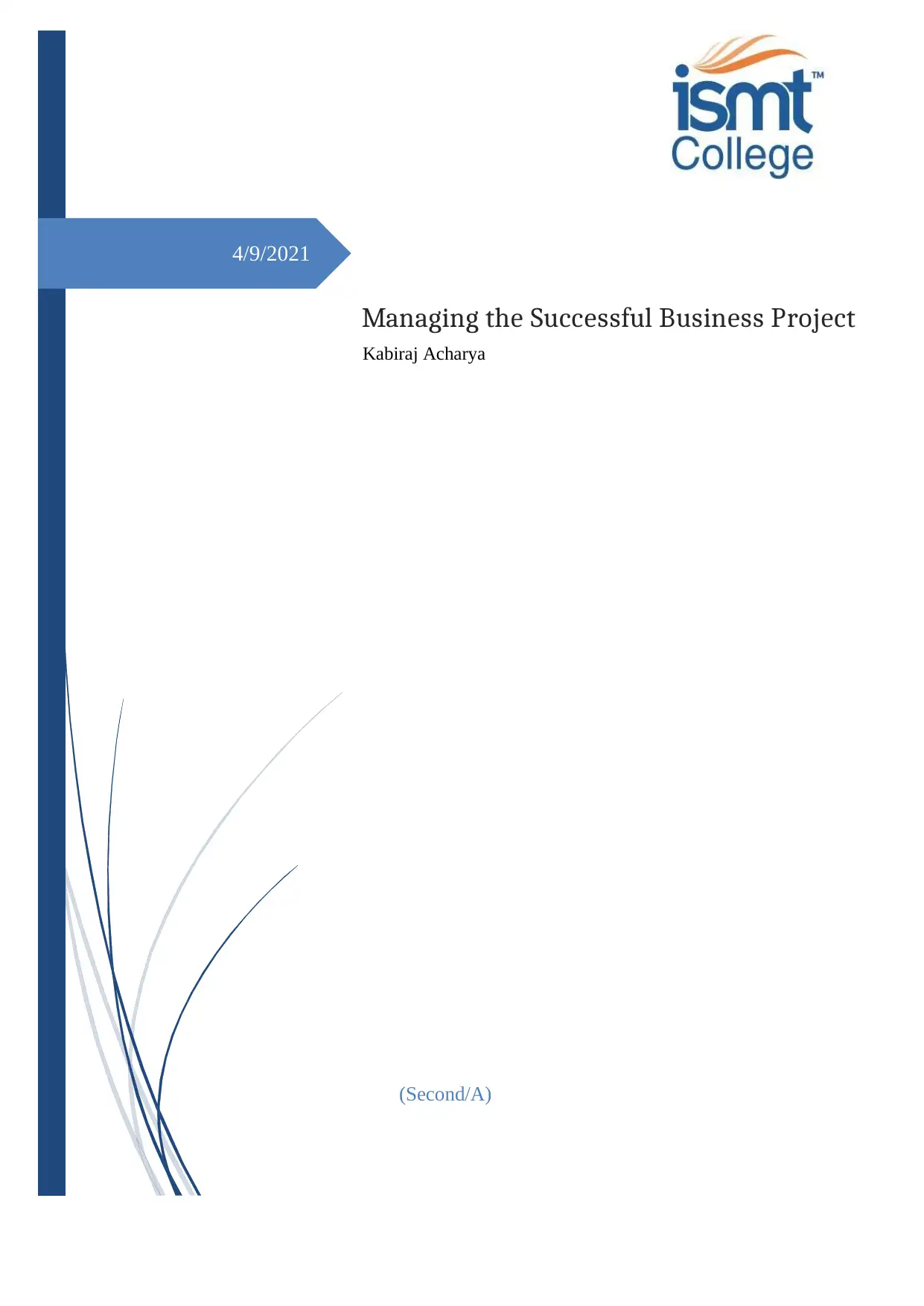
4/9/2021
Managing the Successful Business Project
Kabiraj Acharya
(Second/A)
Managing the Successful Business Project
Kabiraj Acharya
(Second/A)
Paraphrase This Document
Need a fresh take? Get an instant paraphrase of this document with our AI Paraphraser
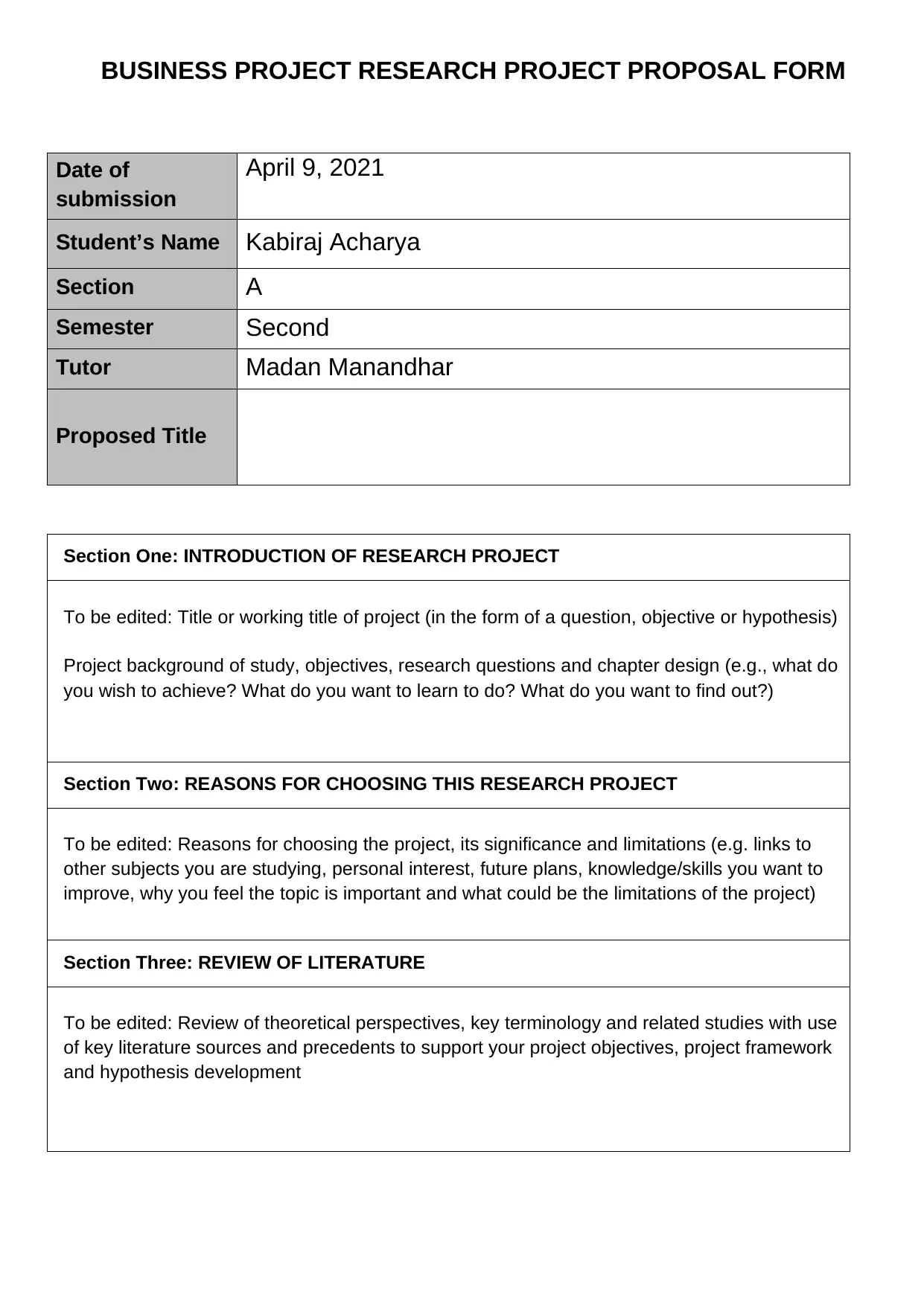
BUSINESS PROJECT RESEARCH PROJECT PROPOSAL FORM
Date of
submission
April 9, 2021
Student’s Name Kabiraj Acharya
Section A
Semester Second
Tutor Madan Manandhar
Proposed Title
Section One: INTRODUCTION OF RESEARCH PROJECT
To be edited: Title or working title of project (in the form of a question, objective or hypothesis)
Project background of study, objectives, research questions and chapter design (e.g., what do
you wish to achieve? What do you want to learn to do? What do you want to find out?)
Section Two: REASONS FOR CHOOSING THIS RESEARCH PROJECT
To be edited: Reasons for choosing the project, its significance and limitations (e.g. links to
other subjects you are studying, personal interest, future plans, knowledge/skills you want to
improve, why you feel the topic is important and what could be the limitations of the project)
Section Three: REVIEW OF LITERATURE
To be edited: Review of theoretical perspectives, key terminology and related studies with use
of key literature sources and precedents to support your project objectives, project framework
and hypothesis development
Date of
submission
April 9, 2021
Student’s Name Kabiraj Acharya
Section A
Semester Second
Tutor Madan Manandhar
Proposed Title
Section One: INTRODUCTION OF RESEARCH PROJECT
To be edited: Title or working title of project (in the form of a question, objective or hypothesis)
Project background of study, objectives, research questions and chapter design (e.g., what do
you wish to achieve? What do you want to learn to do? What do you want to find out?)
Section Two: REASONS FOR CHOOSING THIS RESEARCH PROJECT
To be edited: Reasons for choosing the project, its significance and limitations (e.g. links to
other subjects you are studying, personal interest, future plans, knowledge/skills you want to
improve, why you feel the topic is important and what could be the limitations of the project)
Section Three: REVIEW OF LITERATURE
To be edited: Review of theoretical perspectives, key terminology and related studies with use
of key literature sources and precedents to support your project objectives, project framework
and hypothesis development
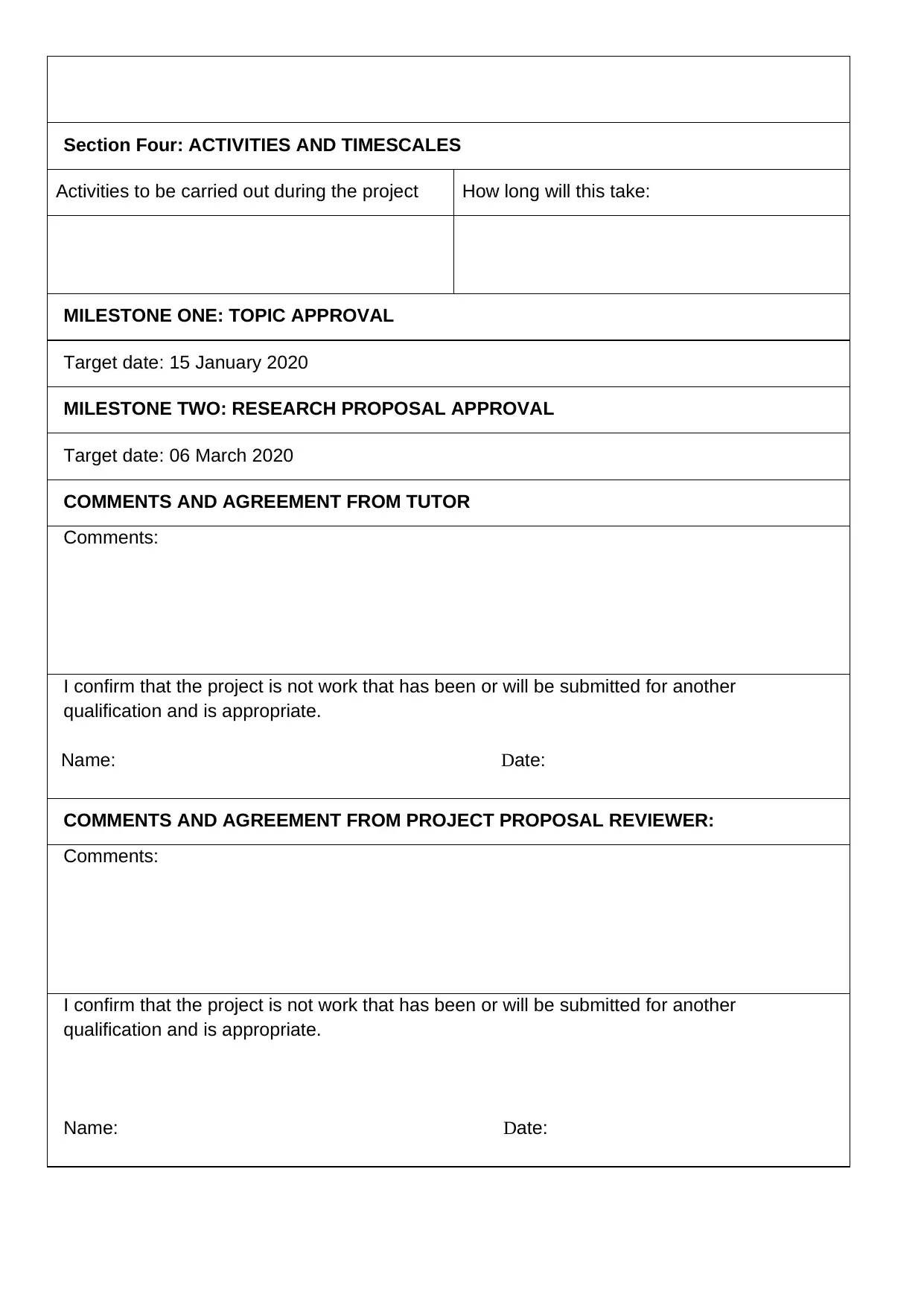
Section Four: ACTIVITIES AND TIMESCALES
Activities to be carried out during the project How long will this take:
MILESTONE ONE: TOPIC APPROVAL
Target date: 15 January 2020
MILESTONE TWO: RESEARCH PROPOSAL APPROVAL
Target date: 06 March 2020
COMMENTS AND AGREEMENT FROM TUTOR
Comments:
I confirm that the project is not work that has been or will be submitted for another
qualification and is appropriate.
Name: Date:
COMMENTS AND AGREEMENT FROM PROJECT PROPOSAL REVIEWER:
Comments:
I confirm that the project is not work that has been or will be submitted for another
qualification and is appropriate.
Name: Date:
Activities to be carried out during the project How long will this take:
MILESTONE ONE: TOPIC APPROVAL
Target date: 15 January 2020
MILESTONE TWO: RESEARCH PROPOSAL APPROVAL
Target date: 06 March 2020
COMMENTS AND AGREEMENT FROM TUTOR
Comments:
I confirm that the project is not work that has been or will be submitted for another
qualification and is appropriate.
Name: Date:
COMMENTS AND AGREEMENT FROM PROJECT PROPOSAL REVIEWER:
Comments:
I confirm that the project is not work that has been or will be submitted for another
qualification and is appropriate.
Name: Date:
⊘ This is a preview!⊘
Do you want full access?
Subscribe today to unlock all pages.

Trusted by 1+ million students worldwide
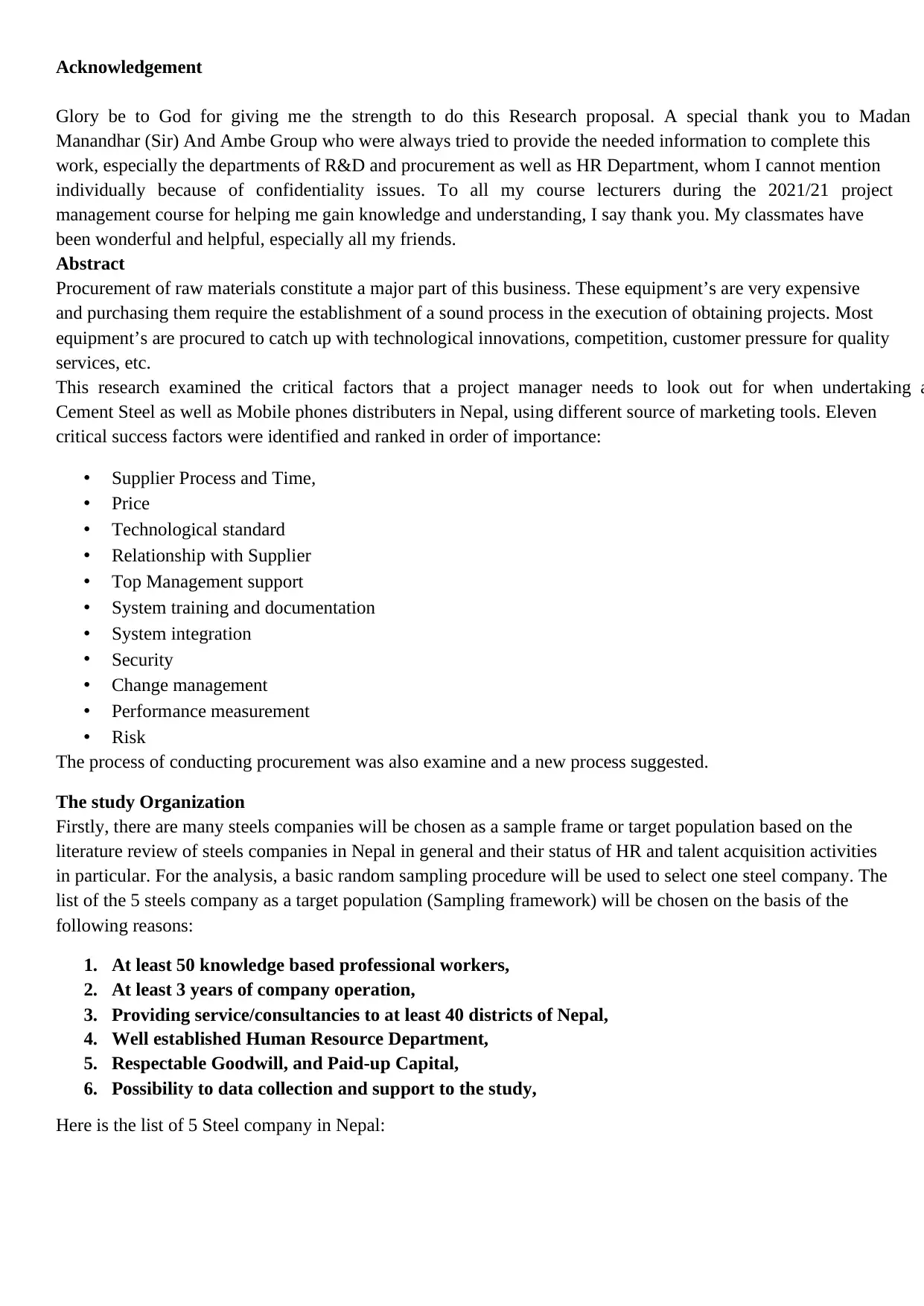
Acknowledgement
Glory be to God for giving me the strength to do this Research proposal. A special thank you to Madan
Manandhar (Sir) And Ambe Group who were always tried to provide the needed information to complete this
work, especially the departments of R&D and procurement as well as HR Department, whom I cannot mention
individually because of confidentiality issues. To all my course lecturers during the 2021/21 project
management course for helping me gain knowledge and understanding, I say thank you. My classmates have
been wonderful and helpful, especially all my friends.
Abstract
Procurement of raw materials constitute a major part of this business. These equipment’s are very expensive
and purchasing them require the establishment of a sound process in the execution of obtaining projects. Most
equipment’s are procured to catch up with technological innovations, competition, customer pressure for quality
services, etc.
This research examined the critical factors that a project manager needs to look out for when undertaking a
Cement Steel as well as Mobile phones distributers in Nepal, using different source of marketing tools. Eleven
critical success factors were identified and ranked in order of importance:
• Supplier Process and Time,
• Price
• Technological standard
• Relationship with Supplier
• Top Management support
• System training and documentation
• System integration
• Security
• Change management
• Performance measurement
• Risk
The process of conducting procurement was also examine and a new process suggested.
The study Organization
Firstly, there are many steels companies will be chosen as a sample frame or target population based on the
literature review of steels companies in Nepal in general and their status of HR and talent acquisition activities
in particular. For the analysis, a basic random sampling procedure will be used to select one steel company. The
list of the 5 steels company as a target population (Sampling framework) will be chosen on the basis of the
following reasons:
1. At least 50 knowledge based professional workers,
2. At least 3 years of company operation,
3. Providing service/consultancies to at least 40 districts of Nepal,
4. Well established Human Resource Department,
5. Respectable Goodwill, and Paid-up Capital,
6. Possibility to data collection and support to the study,
Here is the list of 5 Steel company in Nepal:
Glory be to God for giving me the strength to do this Research proposal. A special thank you to Madan
Manandhar (Sir) And Ambe Group who were always tried to provide the needed information to complete this
work, especially the departments of R&D and procurement as well as HR Department, whom I cannot mention
individually because of confidentiality issues. To all my course lecturers during the 2021/21 project
management course for helping me gain knowledge and understanding, I say thank you. My classmates have
been wonderful and helpful, especially all my friends.
Abstract
Procurement of raw materials constitute a major part of this business. These equipment’s are very expensive
and purchasing them require the establishment of a sound process in the execution of obtaining projects. Most
equipment’s are procured to catch up with technological innovations, competition, customer pressure for quality
services, etc.
This research examined the critical factors that a project manager needs to look out for when undertaking a
Cement Steel as well as Mobile phones distributers in Nepal, using different source of marketing tools. Eleven
critical success factors were identified and ranked in order of importance:
• Supplier Process and Time,
• Price
• Technological standard
• Relationship with Supplier
• Top Management support
• System training and documentation
• System integration
• Security
• Change management
• Performance measurement
• Risk
The process of conducting procurement was also examine and a new process suggested.
The study Organization
Firstly, there are many steels companies will be chosen as a sample frame or target population based on the
literature review of steels companies in Nepal in general and their status of HR and talent acquisition activities
in particular. For the analysis, a basic random sampling procedure will be used to select one steel company. The
list of the 5 steels company as a target population (Sampling framework) will be chosen on the basis of the
following reasons:
1. At least 50 knowledge based professional workers,
2. At least 3 years of company operation,
3. Providing service/consultancies to at least 40 districts of Nepal,
4. Well established Human Resource Department,
5. Respectable Goodwill, and Paid-up Capital,
6. Possibility to data collection and support to the study,
Here is the list of 5 Steel company in Nepal:
Paraphrase This Document
Need a fresh take? Get an instant paraphrase of this document with our AI Paraphraser
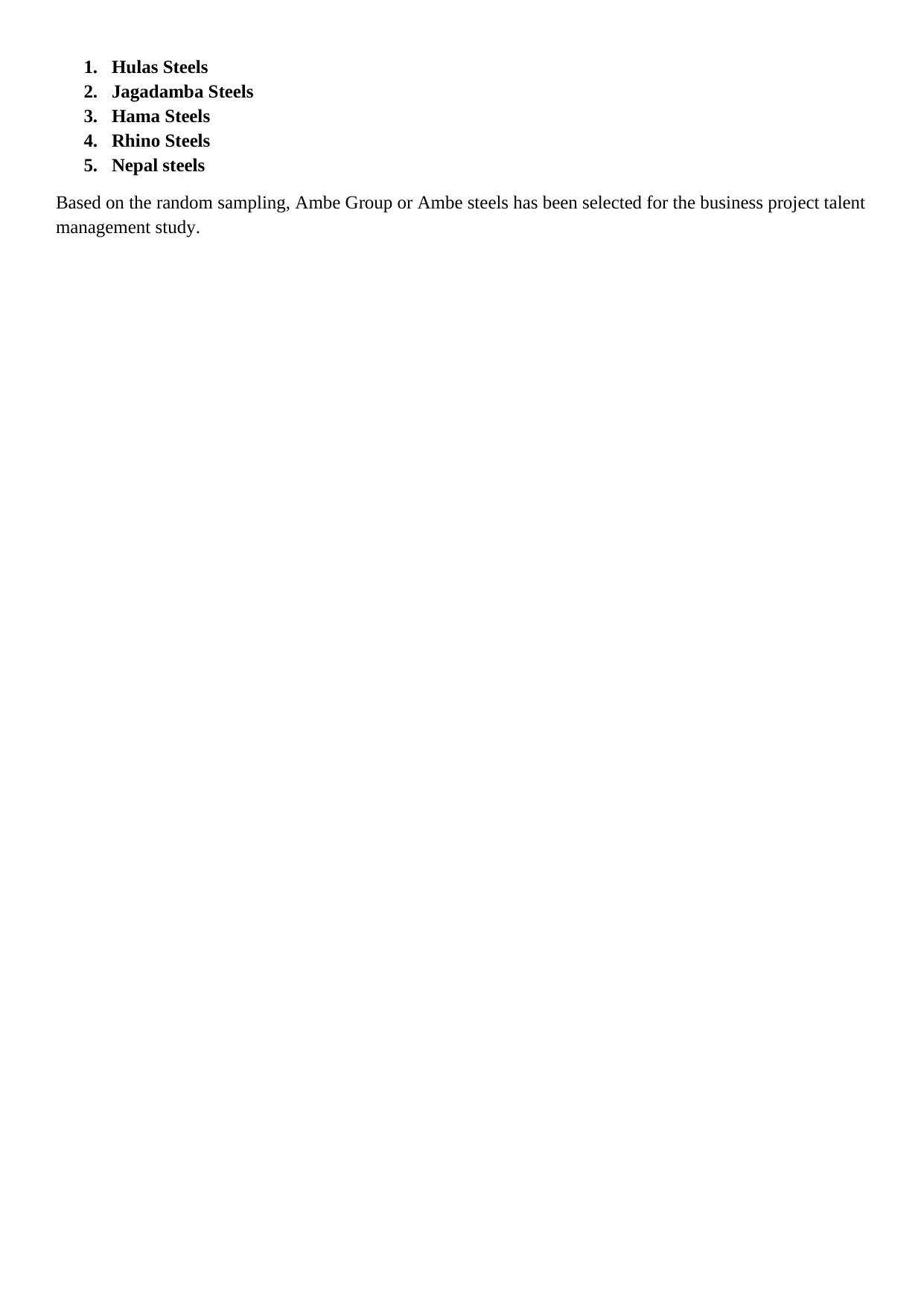
1. Hulas Steels
2. Jagadamba Steels
3. Hama Steels
4. Rhino Steels
5. Nepal steels
Based on the random sampling, Ambe Group or Ambe steels has been selected for the business project talent
management study.
2. Jagadamba Steels
3. Hama Steels
4. Rhino Steels
5. Nepal steels
Based on the random sampling, Ambe Group or Ambe steels has been selected for the business project talent
management study.
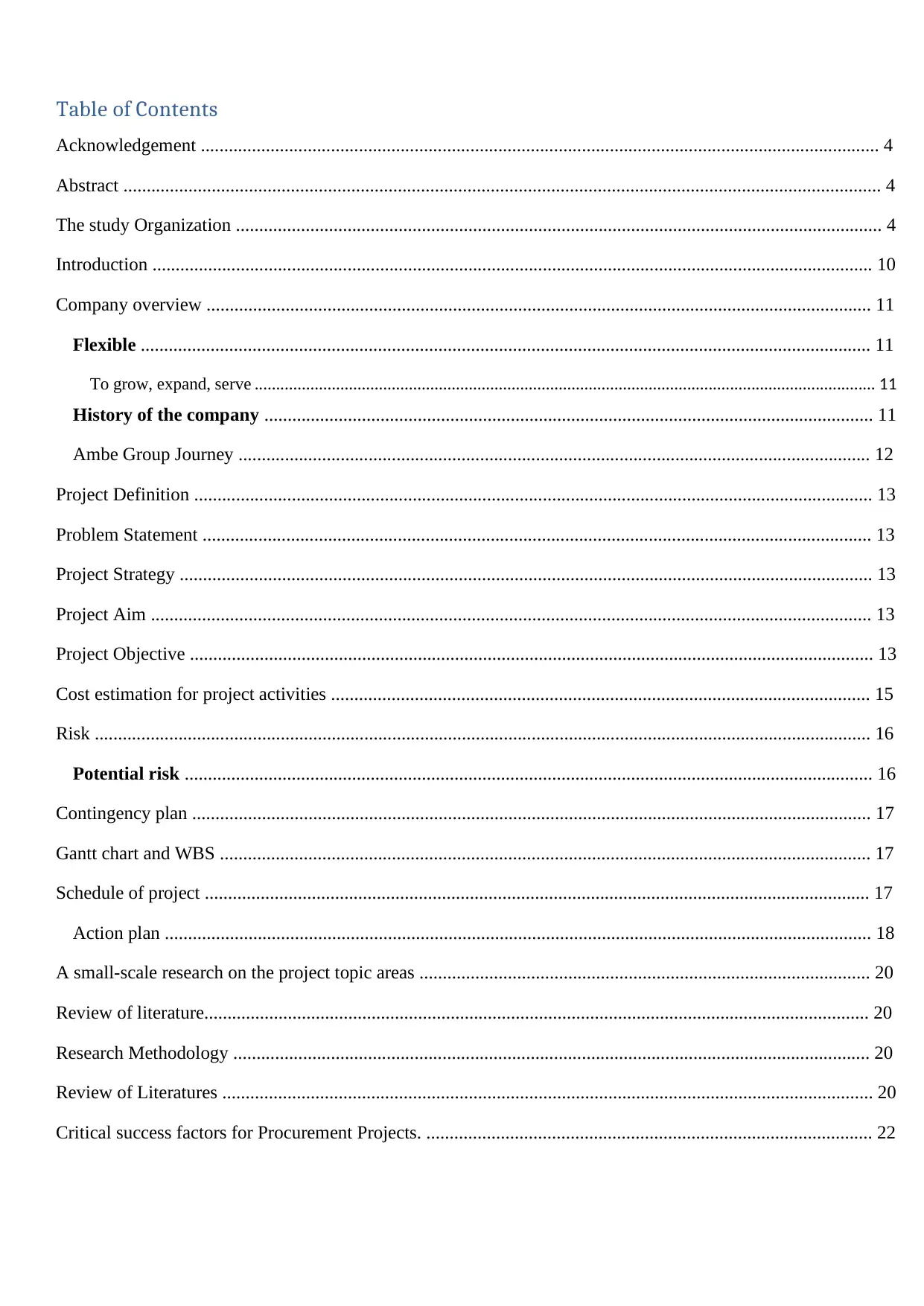
Table of Contents
Acknowledgement .................................................................................................................................................. 4
Abstract ................................................................................................................................................................... 4
The study Organization ........................................................................................................................................... 4
Introduction ........................................................................................................................................................... 10
Company overview ............................................................................................................................................... 11
Flexible ............................................................................................................................................................. 11
To grow, expand, serve ................................................................................................................................................. 11
History of the company ................................................................................................................................... 11
Ambe Group Journey ........................................................................................................................................ 12
Project Definition .................................................................................................................................................. 13
Problem Statement ................................................................................................................................................ 13
Project Strategy ..................................................................................................................................................... 13
Project Aim ........................................................................................................................................................... 13
Project Objective ................................................................................................................................................... 13
Cost estimation for project activities .................................................................................................................... 15
Risk ....................................................................................................................................................................... 16
Potential risk .................................................................................................................................................... 16
Contingency plan .................................................................................................................................................. 17
Gantt chart and WBS ............................................................................................................................................ 17
Schedule of project ............................................................................................................................................... 17
Action plan ........................................................................................................................................................ 18
A small-scale research on the project topic areas ................................................................................................. 20
Review of literature............................................................................................................................................... 20
Research Methodology ......................................................................................................................................... 20
Review of Literatures ............................................................................................................................................ 20
Critical success factors for Procurement Projects. ................................................................................................ 22
Acknowledgement .................................................................................................................................................. 4
Abstract ................................................................................................................................................................... 4
The study Organization ........................................................................................................................................... 4
Introduction ........................................................................................................................................................... 10
Company overview ............................................................................................................................................... 11
Flexible ............................................................................................................................................................. 11
To grow, expand, serve ................................................................................................................................................. 11
History of the company ................................................................................................................................... 11
Ambe Group Journey ........................................................................................................................................ 12
Project Definition .................................................................................................................................................. 13
Problem Statement ................................................................................................................................................ 13
Project Strategy ..................................................................................................................................................... 13
Project Aim ........................................................................................................................................................... 13
Project Objective ................................................................................................................................................... 13
Cost estimation for project activities .................................................................................................................... 15
Risk ....................................................................................................................................................................... 16
Potential risk .................................................................................................................................................... 16
Contingency plan .................................................................................................................................................. 17
Gantt chart and WBS ............................................................................................................................................ 17
Schedule of project ............................................................................................................................................... 17
Action plan ........................................................................................................................................................ 18
A small-scale research on the project topic areas ................................................................................................. 20
Review of literature............................................................................................................................................... 20
Research Methodology ......................................................................................................................................... 20
Review of Literatures ............................................................................................................................................ 20
Critical success factors for Procurement Projects. ................................................................................................ 22
⊘ This is a preview!⊘
Do you want full access?
Subscribe today to unlock all pages.

Trusted by 1+ million students worldwide
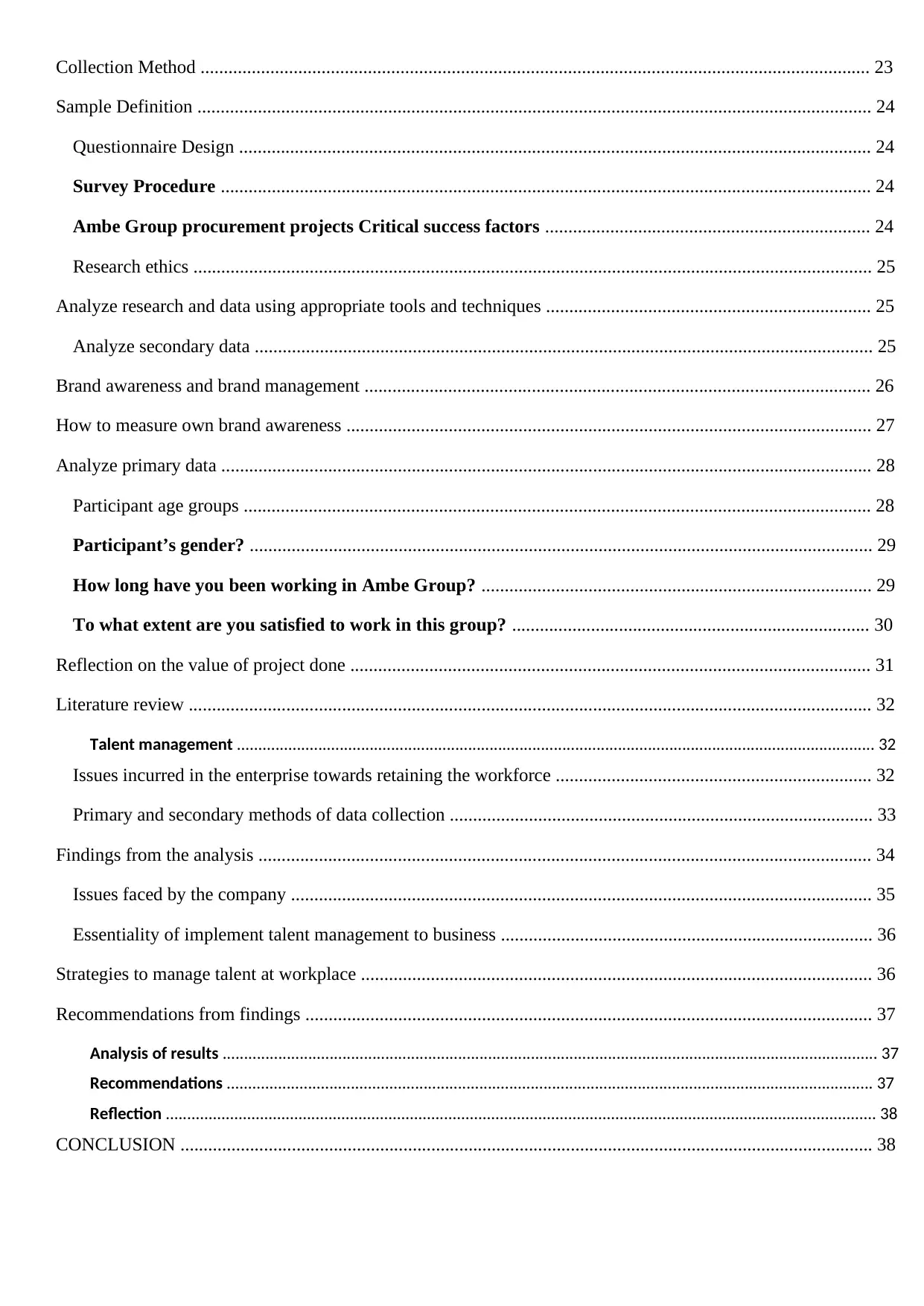
Collection Method ................................................................................................................................................ 23
Sample Definition ................................................................................................................................................. 24
Questionnaire Design ........................................................................................................................................ 24
Survey Procedure ............................................................................................................................................ 24
Ambe Group procurement projects Critical success factors ...................................................................... 24
Research ethics .................................................................................................................................................. 25
Analyze research and data using appropriate tools and techniques ...................................................................... 25
Analyze secondary data ..................................................................................................................................... 25
Brand awareness and brand management ............................................................................................................. 26
How to measure own brand awareness ................................................................................................................. 27
Analyze primary data ............................................................................................................................................ 28
Participant age groups ....................................................................................................................................... 28
Participant’s gender? ...................................................................................................................................... 29
How long have you been working in Ambe Group? .................................................................................... 29
To what extent are you satisfied to work in this group? ............................................................................. 30
Reflection on the value of project done ................................................................................................................ 31
Literature review ................................................................................................................................................... 32
Talent management ..................................................................................................................................................... 32
Issues incurred in the enterprise towards retaining the workforce .................................................................... 32
Primary and secondary methods of data collection ........................................................................................... 33
Findings from the analysis .................................................................................................................................... 34
Issues faced by the company ............................................................................................................................. 35
Essentiality of implement talent management to business ................................................................................ 36
Strategies to manage talent at workplace .............................................................................................................. 36
Recommendations from findings .......................................................................................................................... 37
Analysis of results ......................................................................................................................................................... 37
Recommendations ....................................................................................................................................................... 37
Reflection ...................................................................................................................................................................... 38
CONCLUSION ..................................................................................................................................................... 38
Sample Definition ................................................................................................................................................. 24
Questionnaire Design ........................................................................................................................................ 24
Survey Procedure ............................................................................................................................................ 24
Ambe Group procurement projects Critical success factors ...................................................................... 24
Research ethics .................................................................................................................................................. 25
Analyze research and data using appropriate tools and techniques ...................................................................... 25
Analyze secondary data ..................................................................................................................................... 25
Brand awareness and brand management ............................................................................................................. 26
How to measure own brand awareness ................................................................................................................. 27
Analyze primary data ............................................................................................................................................ 28
Participant age groups ....................................................................................................................................... 28
Participant’s gender? ...................................................................................................................................... 29
How long have you been working in Ambe Group? .................................................................................... 29
To what extent are you satisfied to work in this group? ............................................................................. 30
Reflection on the value of project done ................................................................................................................ 31
Literature review ................................................................................................................................................... 32
Talent management ..................................................................................................................................................... 32
Issues incurred in the enterprise towards retaining the workforce .................................................................... 32
Primary and secondary methods of data collection ........................................................................................... 33
Findings from the analysis .................................................................................................................................... 34
Issues faced by the company ............................................................................................................................. 35
Essentiality of implement talent management to business ................................................................................ 36
Strategies to manage talent at workplace .............................................................................................................. 36
Recommendations from findings .......................................................................................................................... 37
Analysis of results ......................................................................................................................................................... 37
Recommendations ....................................................................................................................................................... 37
Reflection ...................................................................................................................................................................... 38
CONCLUSION ..................................................................................................................................................... 38
Paraphrase This Document
Need a fresh take? Get an instant paraphrase of this document with our AI Paraphraser
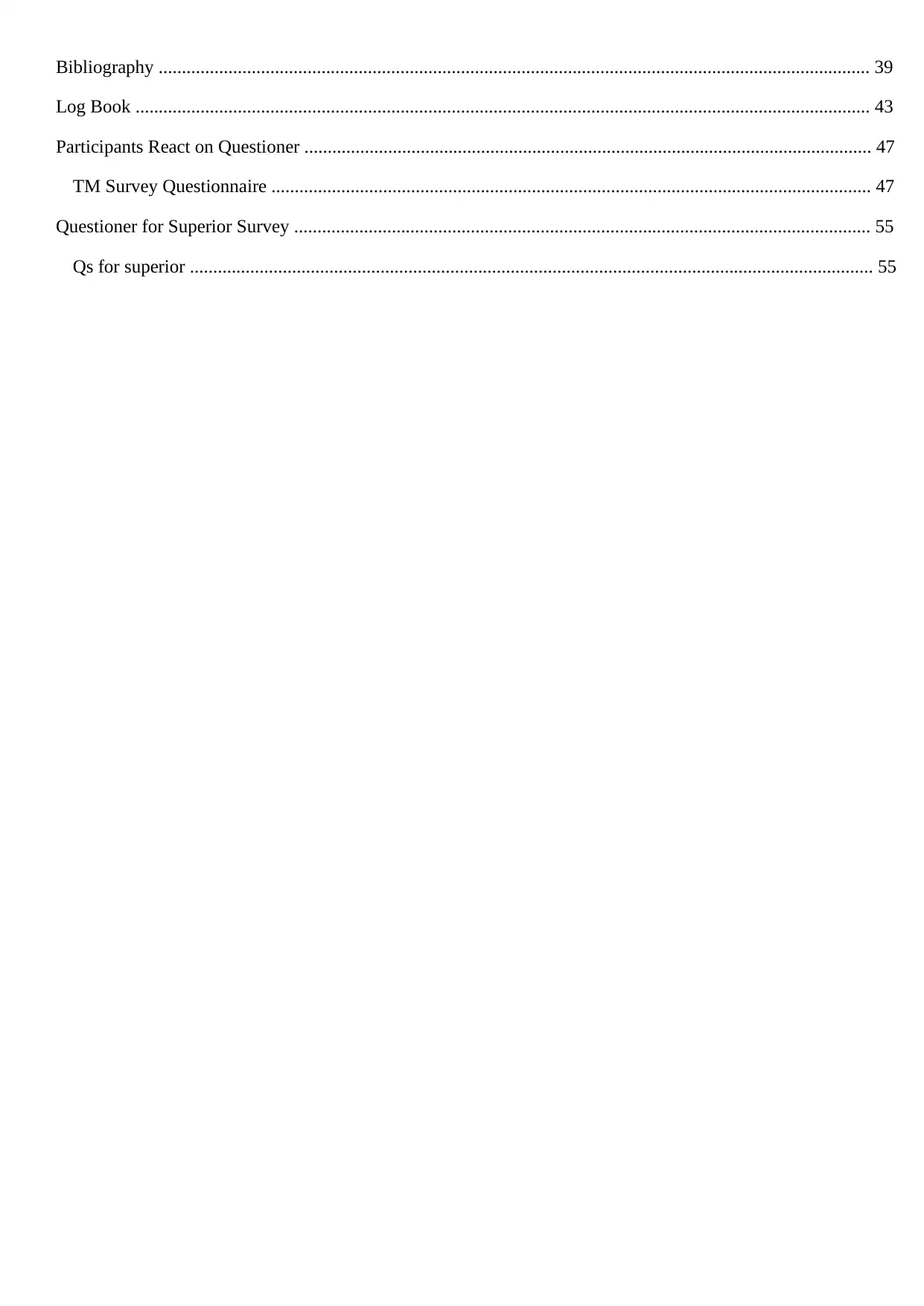
Bibliography ......................................................................................................................................................... 39
Log Book .............................................................................................................................................................. 43
Participants React on Questioner .......................................................................................................................... 47
TM Survey Questionnaire ................................................................................................................................. 47
Questioner for Superior Survey ............................................................................................................................ 55
Qs for superior ................................................................................................................................................... 55
Log Book .............................................................................................................................................................. 43
Participants React on Questioner .......................................................................................................................... 47
TM Survey Questionnaire ................................................................................................................................. 47
Questioner for Superior Survey ............................................................................................................................ 55
Qs for superior ................................................................................................................................................... 55

⊘ This is a preview!⊘
Do you want full access?
Subscribe today to unlock all pages.

Trusted by 1+ million students worldwide
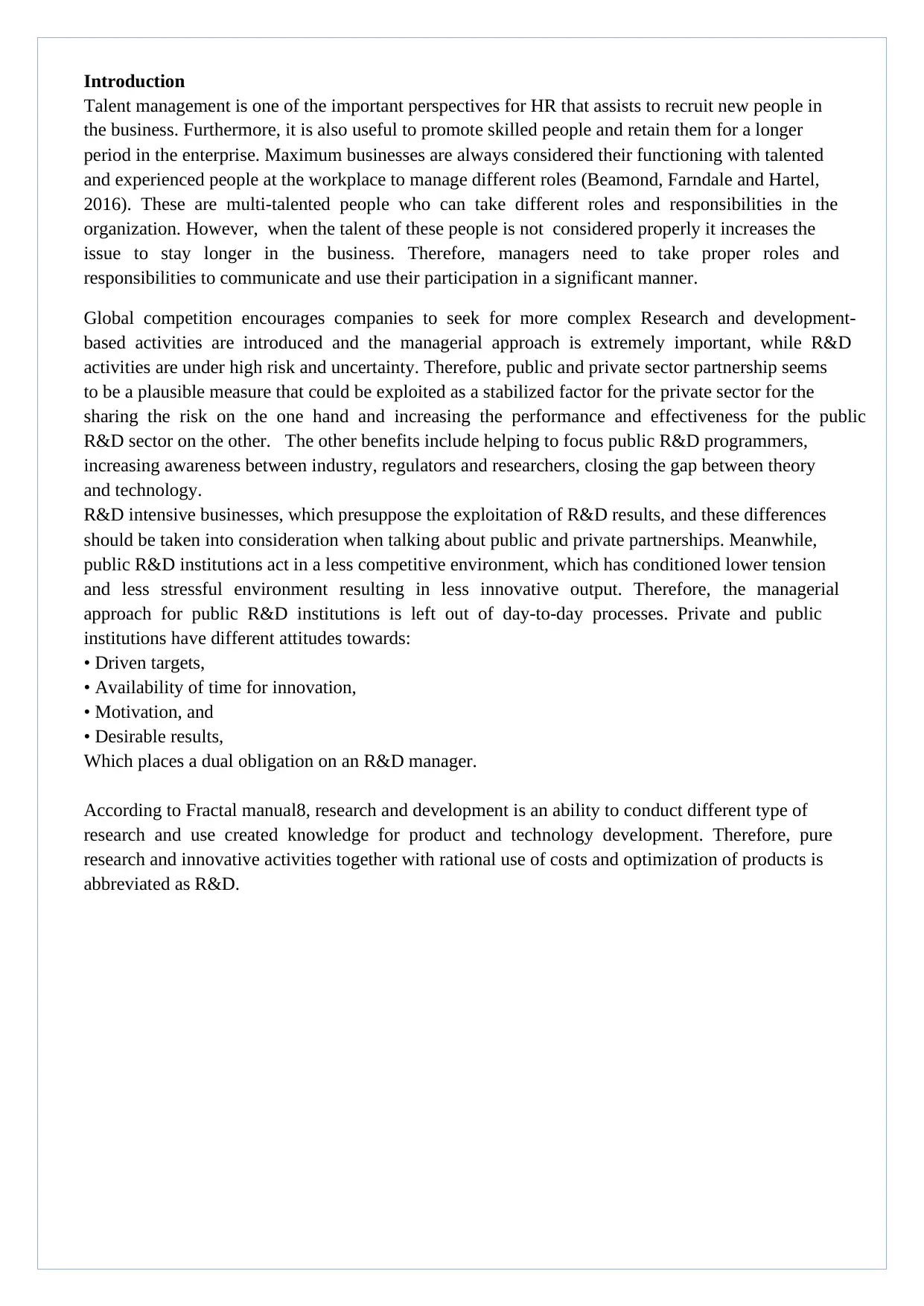
Introduction
Talent management is one of the important perspectives for HR that assists to recruit new people in
the business. Furthermore, it is also useful to promote skilled people and retain them for a longer
period in the enterprise. Maximum businesses are always considered their functioning with talented
and experienced people at the workplace to manage different roles (Beamond, Farndale and Hartel,
2016). These are multi-talented people who can take different roles and responsibilities in the
organization. However, when the talent of these people is not considered properly it increases the
issue to stay longer in the business. Therefore, managers need to take proper roles and
responsibilities to communicate and use their participation in a significant manner.
Global competition encourages companies to seek for more complex Research and development-
based activities are introduced and the managerial approach is extremely important, while R&D
activities are under high risk and uncertainty. Therefore, public and private sector partnership seems
to be a plausible measure that could be exploited as a stabilized factor for the private sector for the
sharing the risk on the one hand and increasing the performance and effectiveness for the public
R&D sector on the other. The other benefits include helping to focus public R&D programmers,
increasing awareness between industry, regulators and researchers, closing the gap between theory
and technology.
R&D intensive businesses, which presuppose the exploitation of R&D results, and these differences
should be taken into consideration when talking about public and private partnerships. Meanwhile,
public R&D institutions act in a less competitive environment, which has conditioned lower tension
and less stressful environment resulting in less innovative output. Therefore, the managerial
approach for public R&D institutions is left out of day-to-day processes. Private and public
institutions have different attitudes towards:
• Driven targets,
• Availability of time for innovation,
• Motivation, and
• Desirable results,
Which places a dual obligation on an R&D manager.
According to Fractal manual8, research and development is an ability to conduct different type of
research and use created knowledge for product and technology development. Therefore, pure
research and innovative activities together with rational use of costs and optimization of products is
abbreviated as R&D.
Talent management is one of the important perspectives for HR that assists to recruit new people in
the business. Furthermore, it is also useful to promote skilled people and retain them for a longer
period in the enterprise. Maximum businesses are always considered their functioning with talented
and experienced people at the workplace to manage different roles (Beamond, Farndale and Hartel,
2016). These are multi-talented people who can take different roles and responsibilities in the
organization. However, when the talent of these people is not considered properly it increases the
issue to stay longer in the business. Therefore, managers need to take proper roles and
responsibilities to communicate and use their participation in a significant manner.
Global competition encourages companies to seek for more complex Research and development-
based activities are introduced and the managerial approach is extremely important, while R&D
activities are under high risk and uncertainty. Therefore, public and private sector partnership seems
to be a plausible measure that could be exploited as a stabilized factor for the private sector for the
sharing the risk on the one hand and increasing the performance and effectiveness for the public
R&D sector on the other. The other benefits include helping to focus public R&D programmers,
increasing awareness between industry, regulators and researchers, closing the gap between theory
and technology.
R&D intensive businesses, which presuppose the exploitation of R&D results, and these differences
should be taken into consideration when talking about public and private partnerships. Meanwhile,
public R&D institutions act in a less competitive environment, which has conditioned lower tension
and less stressful environment resulting in less innovative output. Therefore, the managerial
approach for public R&D institutions is left out of day-to-day processes. Private and public
institutions have different attitudes towards:
• Driven targets,
• Availability of time for innovation,
• Motivation, and
• Desirable results,
Which places a dual obligation on an R&D manager.
According to Fractal manual8, research and development is an ability to conduct different type of
research and use created knowledge for product and technology development. Therefore, pure
research and innovative activities together with rational use of costs and optimization of products is
abbreviated as R&D.
Paraphrase This Document
Need a fresh take? Get an instant paraphrase of this document with our AI Paraphraser
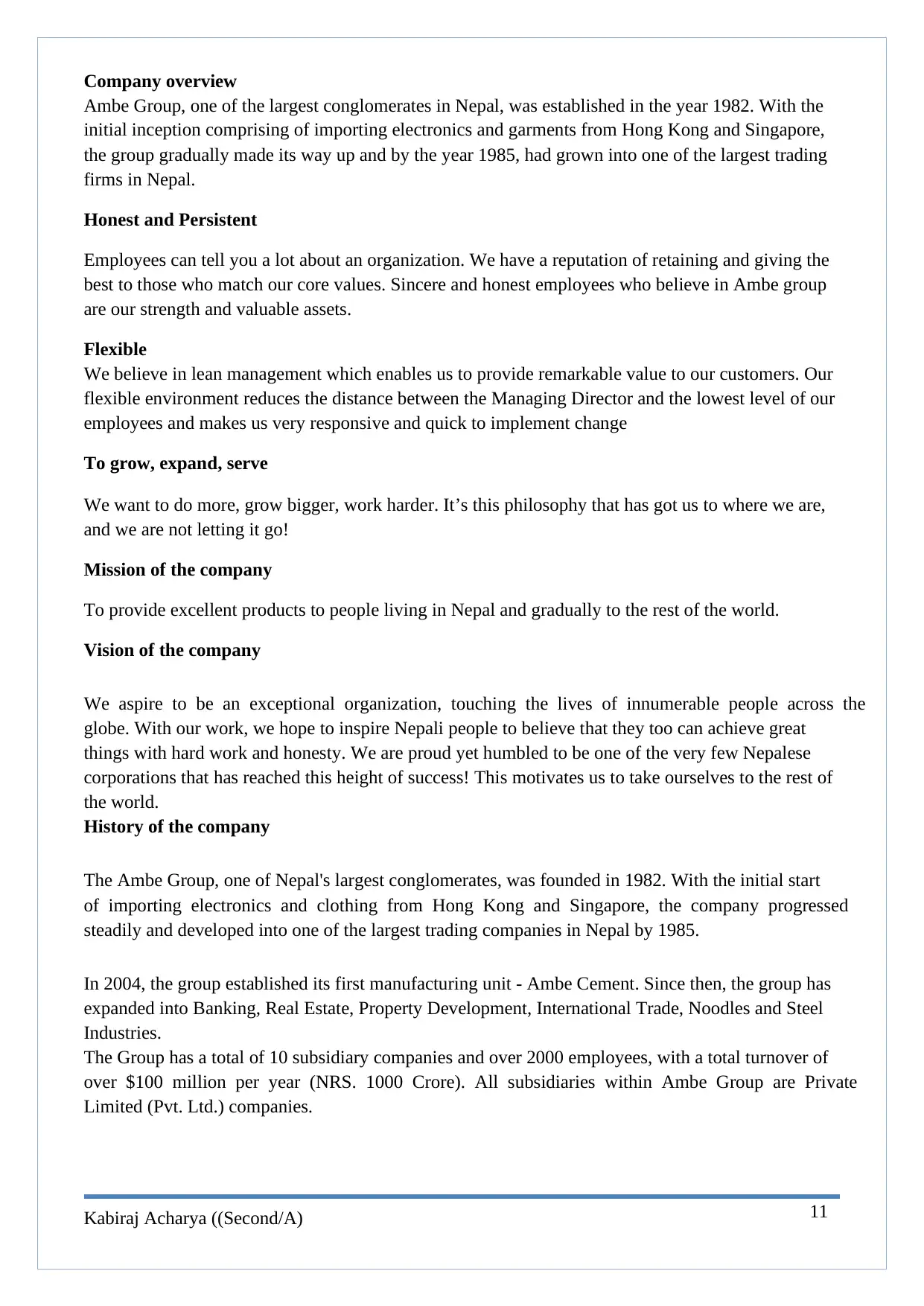
Kabiraj Acharya ((Second/A) 11
Company overview
Ambe Group, one of the largest conglomerates in Nepal, was established in the year 1982. With the
initial inception comprising of importing electronics and garments from Hong Kong and Singapore,
the group gradually made its way up and by the year 1985, had grown into one of the largest trading
firms in Nepal.
Honest and Persistent
Employees can tell you a lot about an organization. We have a reputation of retaining and giving the
best to those who match our core values. Sincere and honest employees who believe in Ambe group
are our strength and valuable assets.
Flexible
We believe in lean management which enables us to provide remarkable value to our customers. Our
flexible environment reduces the distance between the Managing Director and the lowest level of our
employees and makes us very responsive and quick to implement change
To grow, expand, serve
We want to do more, grow bigger, work harder. It’s this philosophy that has got us to where we are,
and we are not letting it go!
Mission of the company
To provide excellent products to people living in Nepal and gradually to the rest of the world.
Vision of the company
We aspire to be an exceptional organization, touching the lives of innumerable people across the
globe. With our work, we hope to inspire Nepali people to believe that they too can achieve great
things with hard work and honesty. We are proud yet humbled to be one of the very few Nepalese
corporations that has reached this height of success! This motivates us to take ourselves to the rest of
the world.
History of the company
The Ambe Group, one of Nepal's largest conglomerates, was founded in 1982. With the initial start
of importing electronics and clothing from Hong Kong and Singapore, the company progressed
steadily and developed into one of the largest trading companies in Nepal by 1985.
In 2004, the group established its first manufacturing unit - Ambe Cement. Since then, the group has
expanded into Banking, Real Estate, Property Development, International Trade, Noodles and Steel
Industries.
The Group has a total of 10 subsidiary companies and over 2000 employees, with a total turnover of
over $100 million per year (NRS. 1000 Crore). All subsidiaries within Ambe Group are Private
Limited (Pvt. Ltd.) companies.
Company overview
Ambe Group, one of the largest conglomerates in Nepal, was established in the year 1982. With the
initial inception comprising of importing electronics and garments from Hong Kong and Singapore,
the group gradually made its way up and by the year 1985, had grown into one of the largest trading
firms in Nepal.
Honest and Persistent
Employees can tell you a lot about an organization. We have a reputation of retaining and giving the
best to those who match our core values. Sincere and honest employees who believe in Ambe group
are our strength and valuable assets.
Flexible
We believe in lean management which enables us to provide remarkable value to our customers. Our
flexible environment reduces the distance between the Managing Director and the lowest level of our
employees and makes us very responsive and quick to implement change
To grow, expand, serve
We want to do more, grow bigger, work harder. It’s this philosophy that has got us to where we are,
and we are not letting it go!
Mission of the company
To provide excellent products to people living in Nepal and gradually to the rest of the world.
Vision of the company
We aspire to be an exceptional organization, touching the lives of innumerable people across the
globe. With our work, we hope to inspire Nepali people to believe that they too can achieve great
things with hard work and honesty. We are proud yet humbled to be one of the very few Nepalese
corporations that has reached this height of success! This motivates us to take ourselves to the rest of
the world.
History of the company
The Ambe Group, one of Nepal's largest conglomerates, was founded in 1982. With the initial start
of importing electronics and clothing from Hong Kong and Singapore, the company progressed
steadily and developed into one of the largest trading companies in Nepal by 1985.
In 2004, the group established its first manufacturing unit - Ambe Cement. Since then, the group has
expanded into Banking, Real Estate, Property Development, International Trade, Noodles and Steel
Industries.
The Group has a total of 10 subsidiary companies and over 2000 employees, with a total turnover of
over $100 million per year (NRS. 1000 Crore). All subsidiaries within Ambe Group are Private
Limited (Pvt. Ltd.) companies.
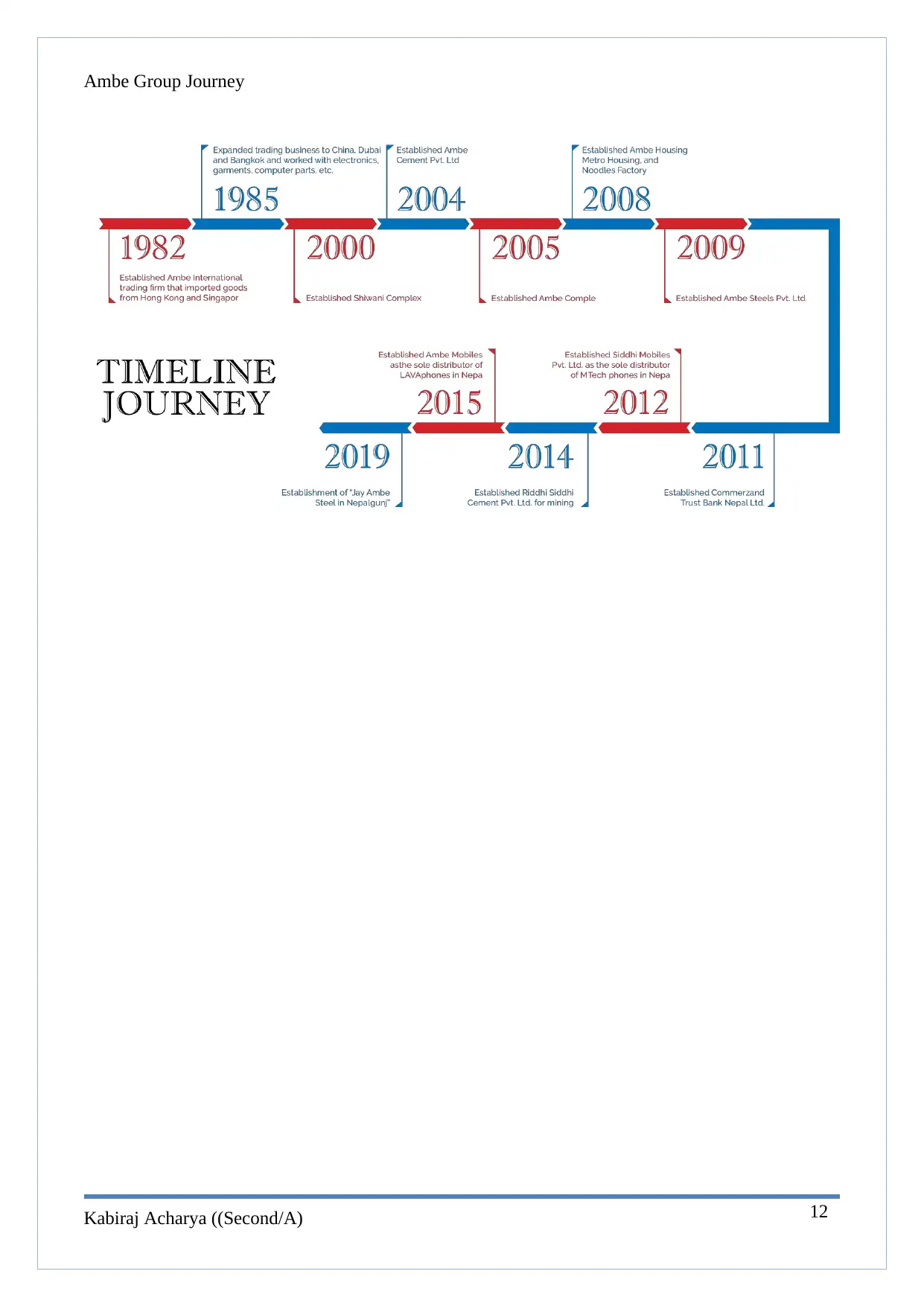
Kabiraj Acharya ((Second/A) 12
Ambe Group Journey
Ambe Group Journey
⊘ This is a preview!⊘
Do you want full access?
Subscribe today to unlock all pages.

Trusted by 1+ million students worldwide
1 out of 59
Related Documents
Your All-in-One AI-Powered Toolkit for Academic Success.
+13062052269
info@desklib.com
Available 24*7 on WhatsApp / Email
![[object Object]](/_next/static/media/star-bottom.7253800d.svg)
Unlock your academic potential
Copyright © 2020–2025 A2Z Services. All Rights Reserved. Developed and managed by ZUCOL.





